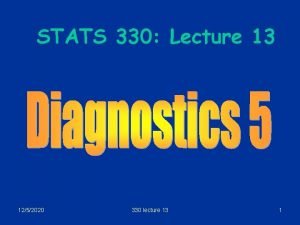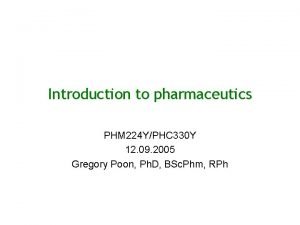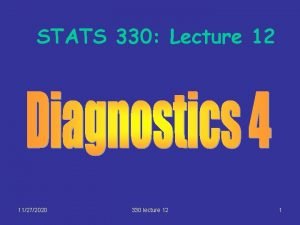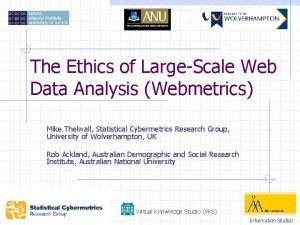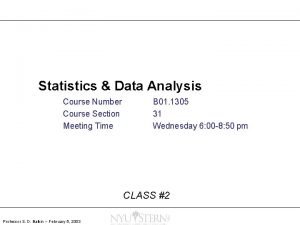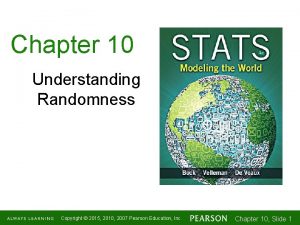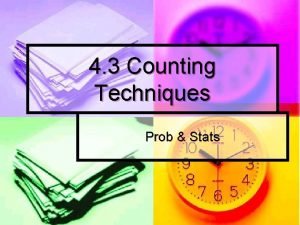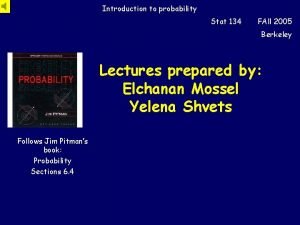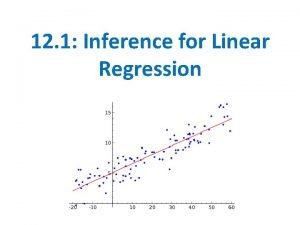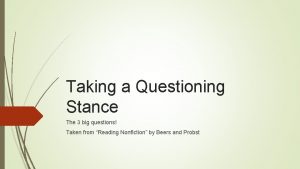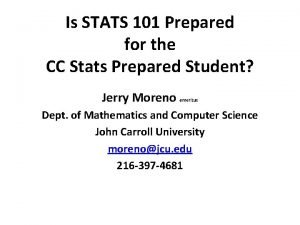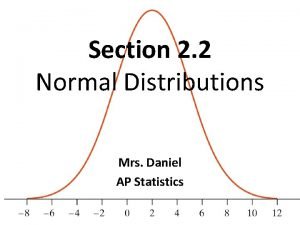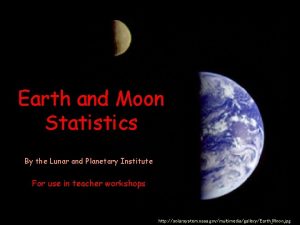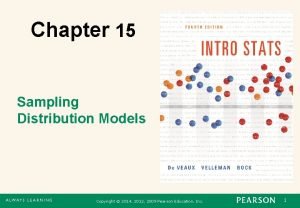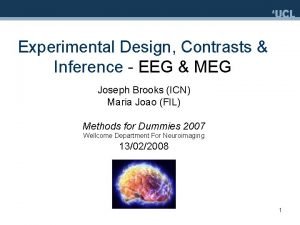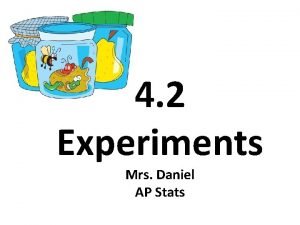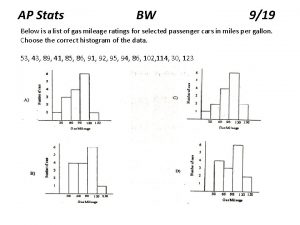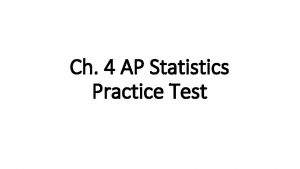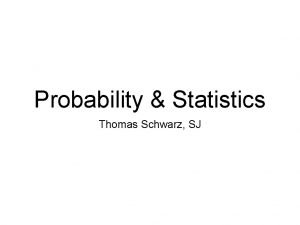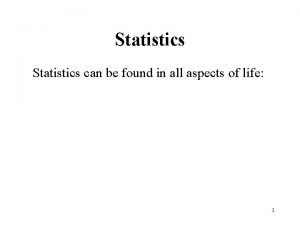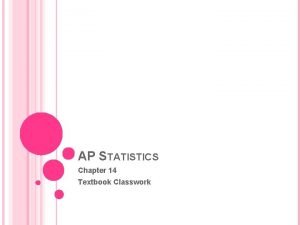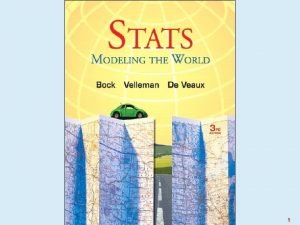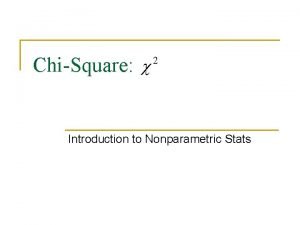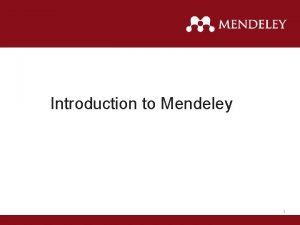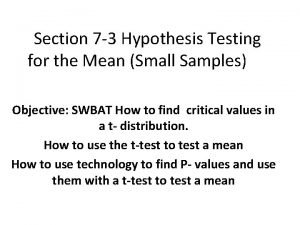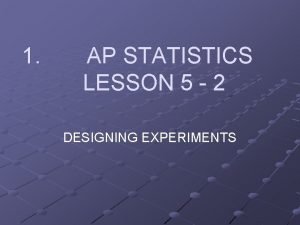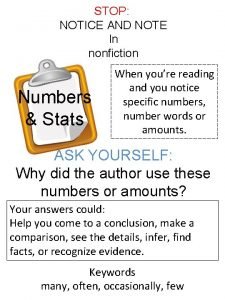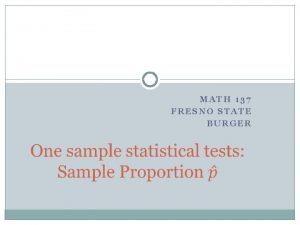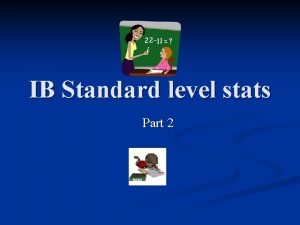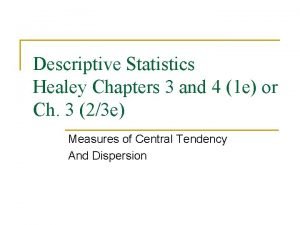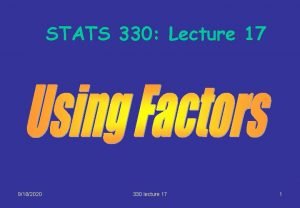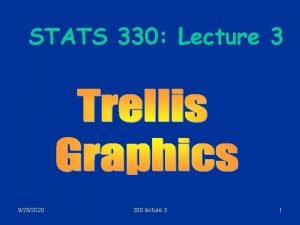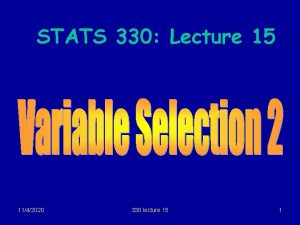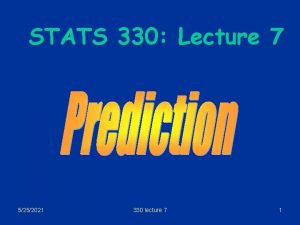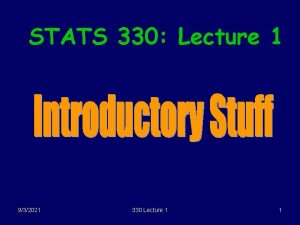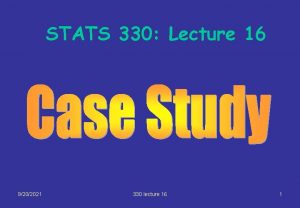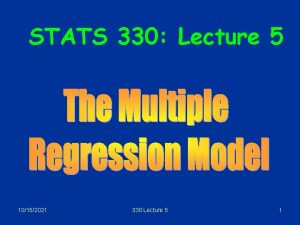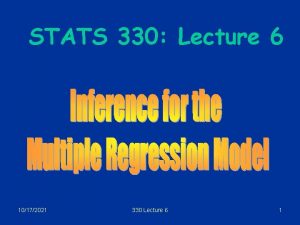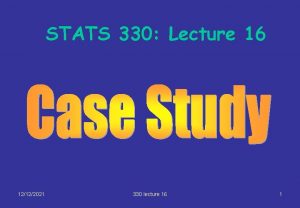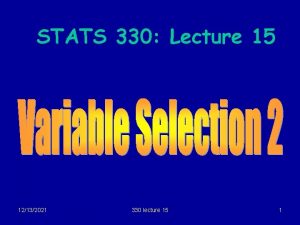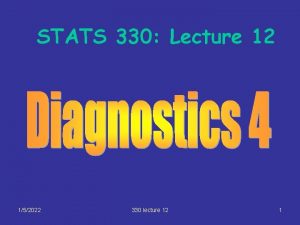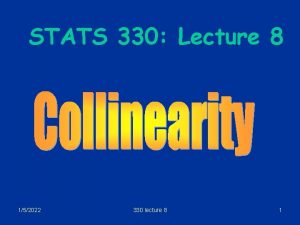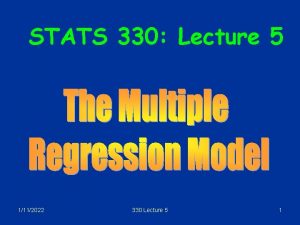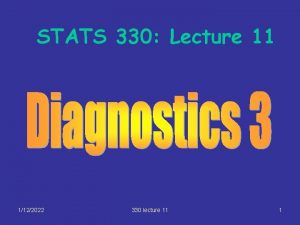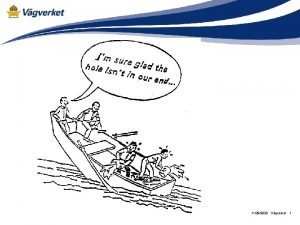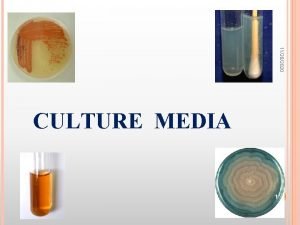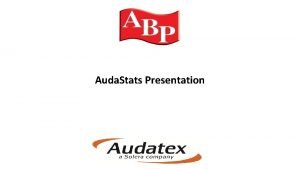STATS 330 Lecture 14 11282020 330 lecture 14

































- Slides: 33

STATS 330: Lecture 14 11/28/2020 330 lecture 14 1

Variable selection Aim of today’s lecture § To describe some techniques for selecting the explanatory variables for a regression § To describe the consequences of making an incorrect choice § To apply these techniques to an example 11/28/2020 330 lecture 14 2

Variable Selection § Often there are several (perhaps a large number) of potential explanatory variables available to build a regression model. Which ones should we use? § We could, of course, use them all. However, sometimes this turns out to be not such a good idea. 11/28/2020 330 lecture 14 3

Overfitting § If we put too many variables in the model, including some unrelated to the response, we are overfitting. Consequences are: • Fitted model is not good for prediction of new data – prediction error is underestimated • Model is too elaborate, models “noise” that will not be the same for new data • Variances of regression coefficients inflated 11/28/2020 330 lecture 14 4

Underfitting § If we put too few variables in the model, leaving out variables that could help explain the response, we are underfitting. Consequences: • Fitted model is not good for prediction of new data – prediction is biased • Regression coefficients are biased • Estimate of error variance is too large 11/28/2020 330 lecture 14 5

Example § Suppose we have some data which follow a quadratic model Y = 1 + 0. 5 x + 4 x 2 + N(0, 1) where the x’s are uniform on [0, 1] The next slide shows the data, with the true regression shown as a dotted line. 11/28/2020 330 lecture 14 6

11/28/2020 330 lecture 14 7

Under/over fitting § Suppose we fit a straight line. This is underfitting, since we are not fitting the squared term. The fitted line (in green) is shown on the next slide. § Alternatively, we could fit a 6 -degree polynomial. This is overfitting, since there are unnecessary terms in x 3, x 4, x 5 and x 6. The fitted polynomial is shown in blue on the next slide. Fit using lm(y~poly(x, 6)) 11/28/2020 330 lecture 14 8

Modelling noise! 11/28/2020 330 lecture 14 9

Points to note § Straight line is biased: can’t capture the curvature in the true regression § 6 -degree line : too variable, attracted to the errors which would be different for a new set of data § Moral: For good models we need to choose variables wisely to avoid overfitting and underfitting. This is called variable selection 11/28/2020 330 lecture 14 10

Uses of regression Two main uses 1. To explain the role(s) of the explanatory variables in influencing the response 2. To construct a prediction equation for predicting the response Consequences of over/under fitting are different in each case 11/28/2020 330 lecture 14 11

Using regression for explanation § Consider the example of heart disease (D), and two risk factors, alcohol (A) and smoking (S). § Studies have found an association between A and D ( a significant regression coef if we regress D on A) § There is also an association between A and S. 11/28/2020 330 lecture 14 12

Explanation (2) Possible explanations for the significant alcohol coefficient: 1. Alcohol consumption causes heart disease 2. Alcohol consumption does not cause heart disease but is associated with smoking that does. 11/28/2020 330 lecture 14 13

Explanation (3) § To decide among these, we can fix S and see if A is related to D for fixed S. This is measured by the coefficient of A in the model including S. Leaving S out gives a biased estimate of the appropriate beta. § Variables like S are called confounders, omitting them leads to misleading conclusions. § Thus, underfitting is potentially more serious than overfitting when interpreting coefficients – see example in the next lecture 11/28/2020 330 lecture 14 14

Prediction § The situation is simpler when we are predicting. We choose the model that will give us the smallest prediction error. This is often not the full model. § We will discuss methods for estimating the prediction error later in the lecture, and in the next lecture 11/28/2020 330 lecture 14 15

Variable selection § If we have k variables, and assuming a constant term in each model, there are 2 k -1 possible subsets of variables, not counting the null model with no variables. How do we select a subset for our model? § Two main approaches: All possible regressions (APR, this lecture) and stepwise methods (SWR, next lecture) 11/28/2020 330 lecture 14 16

All Possible Regressions § For each subset of variables, define a criterion of “model goodness” which tries to balance overfitting (model too complex) with under-fitting (model doesn’t fit very well). § Calculate the criterion for each of the 2 k-1 models (subsets) § Pick the best one according to the criterion. § One difficulty: there are several possible criteria, and they don’t always agree. 11/28/2020 330 lecture 14 17

Possible criteria: 2 R § Since R 2 increases as we add more variables, picking the model with the biggest R 2 will always select the model with all the variables. This will often result in overfitting. § However, R 2 is OK for choosing between models with the same number of variables. § We need to modify R 2 to penalize overly complicated models. One way is to use the adjusted R 2 (p = number of coefficients in model) 11/28/2020 330 lecture 14 18

Interpretation § Suppose we have 2 models: model A with p-1 variables and model B with an additional q variables (we say A is a submodel of B) § Then the adjusted R 2 is defined so that where F is the F statistic for testing that model A is adequate. 11/28/2020 330 lecture 14 19

Residual mean square (RMS) § Recall the estimate of the error variance s 2: estimated by s 2=RSS/(n-p), sometimes called the residual mean square (RMS) § Choose model with the minimum RMS § We can show that this is equivalent to choosing the model with the biggest adjusted R 2 11/28/2020 330 lecture 14 20

AIC and BIC § These are criteria that balance goodness of fit (as measured by RSS) against model complexity (as measured by the number of regression coefficients) § AIC (Akaike Information Criterion) is, up to a constant depending on n , AIC = n log(RMSp) + 2 p RMS = § Alternative version is AIC = RSSp/RMSFull + 2 p, residual equivalent to Cp mean square § BIC (Bayesian Information Criterion) is RSSp/RMSFull + p log(n) § Small values = good model § AIC tends to favour more complex models than BIC 11/28/2020 330 lecture 14 21

Criteria based on prediction error § Our final set of criteria use an estimate of prediction error to evaluate models § They measure how well a model predicts new data 11/28/2020 330 lecture 14 22

Estimating prediction error: Cross-validation § If we have plenty of data, we split the data into 2 parts • The “training set”, used to fit the model and construct the predictor • The “test set”, used to estimate the prediction error § Test set error (=prediction error) estimated by Predicted value using training set predictor with new data § Choose model with smallest prediction error § NB: Using training set to estimate prediction error underestimates the error (old data) 11/28/2020 330 lecture 14 23

Estimating prediction error: Cross-validation (2) § If we don’t have plenty of data, we randomly split the data into 10 parts. One part acts as a test set, the rest as the training set. We compute the prediction error from the test set as before. § Repeat another 9 times, using a different 10 th as the test set each time. Average the estimates to get a good estimate of prediction error § Repeat for different “random splits” § This is “ 10 -fold cross-validation”. Can do 5 -fold, or n-fold, but 10 fold seems to be best. 11/28/2020 330 lecture 14 24

Mallow’s Cp: estimating prediction error Suppose we have a model with p regression coefficients. “Mallows Cp” provides an estimate of how well the model predicts new data, and is given by The subscript FULL refers to the “full model” with k variables. Small values of Cp with Cp about p are good. Warning: Ck+1=k+1 always, so don’t take this as evidence that the full model is good unless all the other Cp’s are bigger. Note similarity to AIC. 11/28/2020 330 lecture 14 25

Example: the fatty acid data The R function allpossregs does the business: eg for the fatty acid data NB This function requires the package “R 330” > fatty. lm <- lm(ffa ~ age + skinfold + weight, data = fatty. df) > library(R 330) > allpossregs(ffa ~ age + skinfold + weight, data = fatty. df) rssp 1 0. 910 2 0. 794 3 0. 791 11/28/2020 sigma 2 0. 051 0. 047 0. 049 adj. Rsq Cp AIC BIC CV age weight skinfold 0. 380 2. 406 24. 397 0. 114 0 1 0 0. 427 2. 062 25. 049 0. 107 1 1 0 0. 394 4. 000 27. 983 0. 117 1 1 1 330 lecture 14 26

Good model 11/28/2020 Good model 330 lecture 14 27

Example: the evaporation data § This was discussed in Tutorial 2: the variables are • evap: the amount of moisture evaporating from the soil in the 24 hour period (response) • maxst: maximum soil temperature over the 24 hour period • minst: minimum soil temperature over the 24 hour period • avst: average soil temperature over the 24 hour period • maxat: maximum air temperature over the 24 hour period • minat: minimum air temperature over the 24 hour period • avat: average air temperature over the 24 hour period • maxh: maximum humidity over the 24 hour period • minh: minimum humidity over the 24 hour period • avh: average humidity over the 24 hour period • wind: average wind speed over the 24 hour period. 11/28/2020 330 lecture 14 28

Variable selection § There are strong relationships between the variables, so we probably don’t need them all. We can perform an all possible regressions analysis using the code evap. df = read. table( "http: //www. stat. auckland. ac. nz/ ~lee/330/datasets. dir/evap. txt", header=TRUE) evap. lm = lm(evap~. , data=evap. df) library(R 330) allpossregs(evap~. , data=evap. df) 11/28/2020 330 lecture 14 29

Call: lm(formula = evap ~. , data = evap. df) Coefficients: Estimate Std. Error t value Pr(>|t|) (Intercept) -54. 074877 130. 720826 -0. 414 0. 68164 avst 2. 231782 1. 003882 2. 223 0. 03276 * minst 0. 204854 1. 104523 0. 185 0. 85393 maxst -0. 742580 0. 349609 -2. 124 0. 04081 * avat 0. 501055 0. 568964 0. 881 0. 38452 minat 0. 304126 0. 788877 0. 386 0. 70219 maxat 0. 092187 0. 218054 0. 423 0. 67505 avh 1. 109858 1. 133126 0. 979 0. 33407 minh 0. 751405 0. 487749 1. 541 0. 13242 maxh -0. 556292 0. 161602 -3. 442 0. 00151 ** wind 0. 008918 0. 009167 0. 973 0. 33733 Residual standard error: 6. 508 on 35 degrees of freedom Multiple R-Squared: 0. 8463, Adjusted R-squared: 0. 8023 F-statistic: 19. 27 on 10 and 35 DF, p-value: 2. 073 e-11 11/28/2020 330 lecture 14 30

> library(R 330) # NB Load R 330 library > allpossregs(evap~. , data=evap. df) rssp sigma 2 adj. Rsq Cp AIC BIC 1 3071. 255 69. 801 0. 674 30. 519 76. 519 80. 177 2 2101. 113 48. 863 0. 772 9. 612 55. 612 61. 098 3 1879. 949 44. 761 0. 791 6. 390 52. 390 59. 705 4 1696. 789 41. 385 0. 807 4. 065 50. 065 59. 208 5 1599. 138 39. 978 0. 813 3. 759 49. 759 60. 731 6 1552. 033 39. 796 0. 814 4. 647 50. 647 63. 448 7 1521. 227 40. 032 0. 813 5. 920 51. 920 66. 549 8 1490. 602 40. 287 0. 812 7. 197 53. 197 69. 654 9 1483. 733 41. 215 0. 808 9. 034 55. 034 73. 321 10 1482. 277 42. 351 0. 802 11. 000 57. 000 77. 115 avst minst maxst avat minat maxat avh minh 1 0 0 0 0 2 0 0 0 1 0 0 3 0 0 0 1 0 0 4 1 0 0 5 1 0 0 1 6 1 0 0 1 7 1 0 1 1 0 0 1 1 8 1 0 1 1 1 9 1 0 1 1 1 1 11/28/2020 330 lecture 14 CV 308. 052 208. 962 191. 622 206. 449 223. 113 233. 692 260. 577 271. 771 302. 781 325. 410 maxh wind 1 0 1 0 1 1 1 31

6, 9, 10 1, 3, 6, 9 1, 3, 6, 8, 9, 10 1, 3, 6, 8, 9 11/28/2020 330 lecture 14 32

> sub. lm = lm(evap~maxat + maxh + wind, data=evap. df) > summary(sub. lm) Coefficients: Estimate Std. Error t value Pr(>|t|) (Intercept) 123. 901800 24. 624411 5. 032 9. 60 e-06 *** maxat 0. 222768 0. 059113 3. 769 0. 000506 *** maxh -0. 342915 0. 042776 -8. 016 5. 31 e-10 *** wind 0. 015998 0. 007197 2. 223 0. 031664 * --Full model was 0. 8463 Residual standard error: 6. 69 on 42 degrees of freedom Multiple R-squared: 0. 805, Adjusted R-squared: 0. 7911 F-statistic: 57. 8 on 3 and 42 DF, p-value: 5. 834 e-15 11/28/2020 330 lecture 14 33
 Stats 330
Stats 330 Stats 330
Stats 330 Stats 330
Stats 330 01:640:244 lecture notes - lecture 15: plat, idah, farad
01:640:244 lecture notes - lecture 15: plat, idah, farad Webmetrics stats
Webmetrics stats Compliment rule stats
Compliment rule stats Understanding randomness chapter 10
Understanding randomness chapter 10 Stats tree diagram
Stats tree diagram Freesurfer color lut
Freesurfer color lut Stats 134
Stats 134 Conditions for inference regression
Conditions for inference regression Questioning stance
Questioning stance Numbers and stats signpost
Numbers and stats signpost In cc stats
In cc stats Itbs scores the normal distribution
Itbs scores the normal distribution Moon stats
Moon stats Ap stats chapter 17 sampling distribution models
Ap stats chapter 17 sampling distribution models Extreme language signpost
Extreme language signpost Meg joseph
Meg joseph Mrs daniel ap stats
Mrs daniel ap stats Ap stats
Ap stats Tonya wanted to estimate the average amount
Tonya wanted to estimate the average amount Stats
Stats Experimental unit stats
Experimental unit stats Ap stats chapter 14
Ap stats chapter 14 Ap stats chapter 17 sampling distribution models
Ap stats chapter 17 sampling distribution models Stats
Stats Mendeley stats
Mendeley stats Statistics hypothesis
Statistics hypothesis What are experimental units in stats
What are experimental units in stats Notice and note nonfiction
Notice and note nonfiction What is p hat stats
What is p hat stats Combined standard deviation formula
Combined standard deviation formula Iqv stats calculator
Iqv stats calculator
